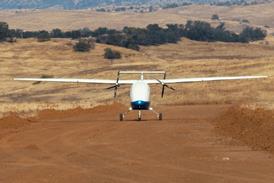The US Air Force (USAF) has officially awarded Nevada-based Sierra Nevada Corporation the contract to deliver its next generation of so-called “Doomsday” aircraft.
Officially known as the Survivable Airborne Operations Center (SAOC), the new aircraft will replace the air force’s Boeing E-4B Nightwatch jet, which is capable of commanding the USA’s nuclear arsenal from aloft.
“The SAOC weapon system is intended to replace the ageing 1970s-era aircraft, which are approaching end-of-service life,” the air force says.
“The development of this critical national security weapon system ensures the [USA’s] nuclear command, control and communications capability is operationally relevant and secure for decades to come,” the service adds.
The contract is worth $13 billion to Sierra Nevada, with work expected to be complete by 2036.
Airframer Boeing had been competing against Sierra Nevada to build the new SAOC. However, the aerospace giant withdrew its bid in 2023, citing an impasse with the USAF related to contract terms.

Boeing has lost billions of dollars in recent years on fixed-price contracts for the development of new military aircraft. While the Pentagon increasingly favours this approach as a method for controlling costs, it forces manufacturers to assume greater financial risk for any delays or engineering challenges.
Major US aerospace manufacturers, including Boeing and Northrop Grumman, have walked away from potentially lucrative new procurement programmes, citing a desire to be more financially cautious.
“We haven’t signed any fixed-price contracts, nor do we intend to,” said Boeing’s chief financial officer Brian West said during an earnings call last October.
Northrop bowed out of another highly-sensitive USAF development effort: the Next Generation Air Dominance programme to design a sixth-generation fighter.

At the time of its withdrawal from the SAOC contest, Boeing said it was “approaching all new contract opportunities with added discipline to ensure we can meet our commitments and support the long-term health of our business”.
The company’s departure from the competition in 2023 left Sierra Nevada as the sole bidder and heir apparent to the Doomsday jet programme.
Similar to the current E-4B, which is a heavily modified Boeing 747-200 commercial airliner, the next-generation SAOC will be a commercial derivative aircraft, according to the air force.
“[It] will be hardened and modified to meet military requirements,” the service notes. ”The mission system will integrate secure communications and planning capabilities on modern information technology.”
The Pentagon describes the ability to command the nation’s military forces – including its nuclear arsenal – from a mobile, airborne station as critical to deterring adversaries from conducting strategic attacks against the USA or Washington’s allies and partners.
In the event of a national emergency or the destruction of ground-based command centres, the E-4B would provide national leaders the ability to coordinate actions by civil authorities, direct US forces and execute emergency war orders, including the launch of nuclear weapons.
























